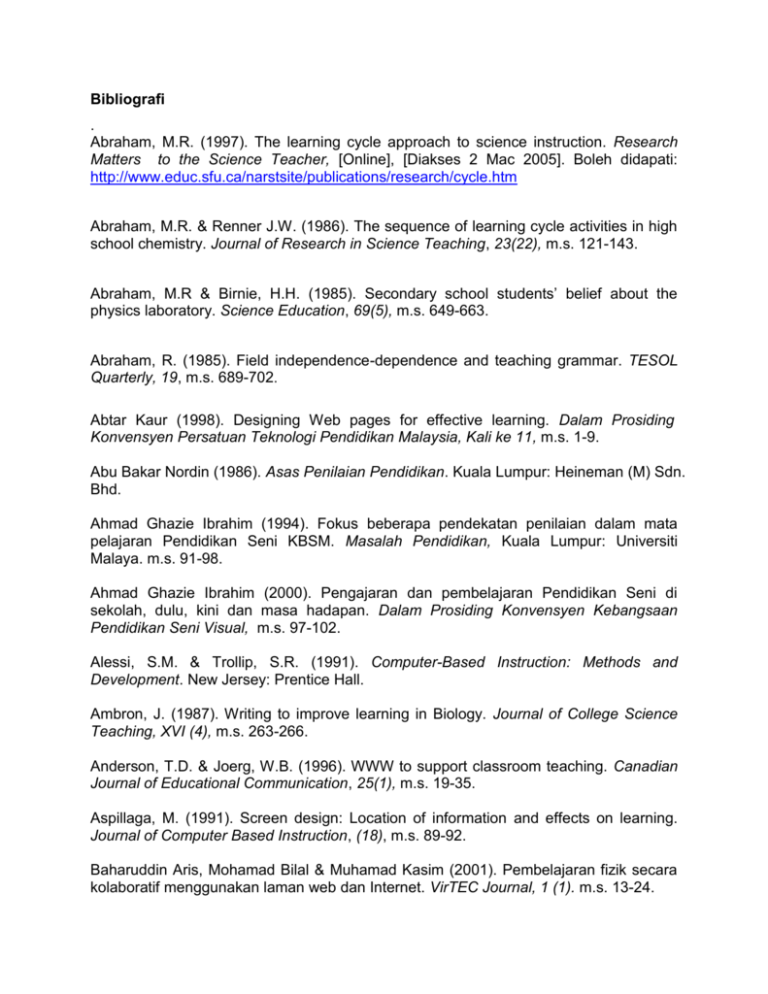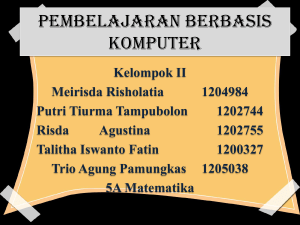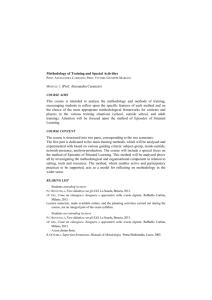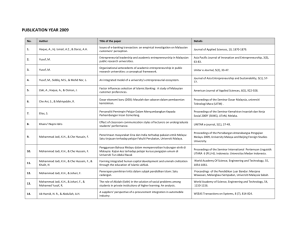Contoh menulis Bibliografi
advertisement

Bibliografi . Abraham, M.R. (1997). The learning cycle approach to science instruction. Research Matters to the Science Teacher, [Online], [Diakses 2 Mac 2005]. Boleh didapati: http://www.educ.sfu.ca/narstsite/publications/research/cycle.htm Abraham, M.R. & Renner J.W. (1986). The sequence of learning cycle activities in high school chemistry. Journal of Research in Science Teaching, 23(22), m.s. 121-143. Abraham, M.R & Birnie, H.H. (1985). Secondary school students’ belief about the physics laboratory. Science Education, 69(5), m.s. 649-663. Abraham, R. (1985). Field independence-dependence and teaching grammar. TESOL Quarterly, 19, m.s. 689-702. Abtar Kaur (1998). Designing Web pages for effective learning. Dalam Prosiding Konvensyen Persatuan Teknologi Pendidikan Malaysia, Kali ke 11, m.s. 1-9. Abu Bakar Nordin (1986). Asas Penilaian Pendidikan. Kuala Lumpur: Heineman (M) Sdn. Bhd. Ahmad Ghazie Ibrahim (1994). Fokus beberapa pendekatan penilaian dalam mata pelajaran Pendidikan Seni KBSM. Masalah Pendidikan, Kuala Lumpur: Universiti Malaya. m.s. 91-98. Ahmad Ghazie Ibrahim (2000). Pengajaran dan pembelajaran Pendidikan Seni di sekolah, dulu, kini dan masa hadapan. Dalam Prosiding Konvensyen Kebangsaan Pendidikan Seni Visual, m.s. 97-102. Alessi, S.M. & Trollip, S.R. (1991). Computer-Based Instruction: Methods and Development. New Jersey: Prentice Hall. Ambron, J. (1987). Writing to improve learning in Biology. Journal of College Science Teaching, XVI (4), m.s. 263-266. Anderson, T.D. & Joerg, W.B. (1996). WWW to support classroom teaching. Canadian Journal of Educational Communication, 25(1), m.s. 19-35. Aspillaga, M. (1991). Screen design: Location of information and effects on learning. Journal of Computer Based Instruction, (18), m.s. 89-92. Baharuddin Aris, Mohamad Bilal & Muhamad Kasim (2001). Pembelajaran fizik secara kolaboratif menggunakan laman web dan Internet. VirTEC Journal, 1 (1). m.s. 13-24. Baek, Y.K. & Layne, B.H. (1988). Color, graphics, and animation in a computerassisted learning tutorial lesson. Journal of Computer-Based Instruction, 15(4), m.s. 131-135. Becker, D. A. & Dwyer, M. M. (1994). Using hypermedia to provide learner control. Journal of Educational Multimedia and Hypermedia, 3 (2), m.s. 155- 172. Best, J.W. & Kahn, J.V. (1998). Research in Education (8th ed), Needham Height, MA: Allyn & Bacon. Beyon, J. & Macky, H. (1993). Computer based Instruction: Methods and Development . NJ: Prentice Hall. Bland, J., Sundberg, C.W. & Goldston, M.J. (2004). The impact of an on line Learning Cycle Module with pre-service elementary science teachers, American Educational Research Association. [Online], [Diakses 12 Feb 2005]. Boleh didapati: http://convention.allacademic.com/aera2004/view_paper_info.html Bodzine, A. & Cats, W. (2003). Enhancing preservice teachers’ understanding of Webbased scientific inquiry. Journal of Science Teacher Education, 14(4), m.s. 1006-1072. Borg, C. & Gall, M.D. (1989), Educational Research: An Introduction (5th ed), New York: Longman. Broadband Technology in Malaysia (2004). International Business Strategies, [Online], [Diakses 12 Feb 2005]. Boleh didapati: http://www.internationalbusinesstrategies.com/data/TOC/27180411malaysia_broad_pag es1-2.pdf Brooks, J.G. & Brooks, M.G. (1993). Traditional vs. constructivist classrooms. Alexandria, VA: Association for Supervision and Curriculum Development, (ASCD). Bruner, J.S. (1960). The Process of Education. New York : Vintage Books. Brunner, J.B. (1974). Beyond the Information Given. New York: Notton. Bruning, R., Schraw, G. & Ronning, (1995). Cognitive Psychology and Instruction. (2nd Ed.), Englewood Cliffs, NJ: Prentice-Hall. Carin, A.A. & Sund, R.B. (1971). Developing Question Techniques: A Self-Concept Approach. Columbus, OH: Charles E. Merrill. Carlson, D.A. (1975). Training in formal reasoning abilities provided by the inquiry role approach and achievement on the Piagetian formal operational level. Dissertation Abstract, 36 (11) :7364A. Chang H.W. (1997). Teori Seni Tampak: Asas Seni Reka. Kuala Lumpur: Dewan Bahasa dan Pustaka. Chinien, C. & Boutin, F. (1993). Cognitive style FD/FI: An important learner characteristic for educational technologists. Journal of Educational Technology Systems, 21(24), m.s. 303-311. Ching, L., Chen, S.Y. & Macredie, R.D. (2002). Cognitive styles and hypermedia navigation: Development of a learning model. Journal of the American Society for Information Science and Technology, 53(1), m.s. 375-402. Chou, C. & Lin, H. (1998). The effect of navigation map types and cognitive styles on learners’ performance in computer-networked hypertext learning system. Journal of Educational Multimedia and Hypermedia, 7(2/3), m.s. 151-176. Collins, A. & Stevens, A.L. (1983). A cognitive theory of inquiry teaching. Di dalam Reigeluth (Ed.) Instructional Design Theories and Models: An Overview of Their Current Status, Hillsdale: Lawrence Earlbaum Associates. m.s. 250-276. Collins, B. (1996). The Internet as an educational innovation: Lessons from experience with computer implementation. Educational Technology, 36 (6), m.s. 21-30. Cook, T.D. & Campbell, D.F. (1979). Quasi-Experimentation Design & Analyisis Issues for Field Settings. Chicago: Rand Mc Nally. Day, T.M. (1996). The effects of www instruction on learning styles on achievement and changes in student attitudes in a technical writing in agricommunication course. MSc Thesis, Mississippi State University, Dissertation Abstract, [Online], AA113824767, [Diakses 12 Jan 2005]. Boleh didapati: http://education.ti.com/us/resources/research/parta.html De Grave, W.S., Dolmans, D. & Van Der Vleuten, C.P.M. (1999). Profiles of effective tutors in PBL: Scaffolding student learning. Medical Education, 33, m.s. 901-906. Dershem, H. (1996). Finding and developing research experiences for undergraduates in the small college setting. The Journal of Computing in Small Colleges, 12(12), m.s. 94-95. Dick, W., Carey, L. M., & Carey, J.O. (2001). The Systematic Design of Instruction (5th Ed.). New York: Addison-Wesley. Duin, A.H. (1988). Factors that influence how readers learn from text: Guidelines for structuring technical documents. Technical Communication, (36), m.s. 97-101. Durfensne, A. & Turcotte, S. (1997). Cognitive style and its implications for navigation strategies. [Online], [Diakses: 5 April 2004]. Boleh didapati: http://www.esi.umontreal.ca/~dufresne/CONTENU2.html. DiVesta, F. (1975). Trait-treatment interaction, cognitive processes, and research on communication media. A V Communication Review, (23), m.s. 185-196. Driver, R., Squires, A., Rushworth, P. & Wood, R.V. (1994). Making Sense of Secondary Science: Research into Children’s Ideas. New York: Routhledge. Eager, B. (1994). Using the World Wide Web. Indianapolis: Que Corporation. Eager, B., Pike, M. A., Chandler, D., Cook, D. Kirkner, B. & Minatel, J.M. (1995). Using The World Wide Web and Mosaic (Special Edition). Indianapolis IN: Que Corporation. Ebel, R.L. (1979). Essentials of Education Measurement (2nd ed.), Englewood Cliffs, NJ: Prentice Hall. Faeza Mohamed Asri & Merza Abbas (2005). Kesan kitar pembelajaran terhadap kefahaman konsep dan penaakulan saintifik di kalangan pelajar tingkatan satu dalam subjek sains. Dalam Prosiding Konvensyen Teknologi Pendidikan ke- 18, m.s. 756-775. Ford, N. & Chen, S.Y. (2000), Individual differences, hypermedia navigation and learning: An empirical study. Journal of Educational Multimedia and Hypermedia, 9 (2), m.s. 73-81. Fortier, F. (2000). Virtual communities, real struggles: Seeking alternatives for democractic networking: Dalam Gurstein, M. (Ed) Community Informatics: Enabling Communities with Information and Communication Technologies. London: Idea Group Publishing. Fosnot, C.T. (1989). Enquiring Teacher, Enquiring Learners: A Constructivist Approach to Teaching. Wolfebro, NH: Teachers College Press. Gagne, R.M. (1985). The Condition of Learning (4th ed.). New York: Holt Rine Hart & Winston. Gagne, R.M. & Driscoll, M.P.(1988). Essential of Learning for Instruction. (2nd. ed.). Englewood Cliffs, NJ: Prentice Hall. Gagne, R.M., Wager, W. & Rojas, A. (1981). Planning and authoring computer-assisted instruction lessons. Educational Technology, (29), m.s. 17-6. Gatlin, L. S. (1998). The effect of pedagogy infomed by constructivism: A comparison of student achievement across constructivist and traditional classroom enviroments (Science education). (Ph.D Dissertation, University of New Orleans). UMI ProQuest Digital Dissertations Publications No.AAT 9900967. Geber, C. (1993). Booming commercial use changes face of Internet, Infoworld, 15(15), m.s.1-53. Governor, D. (1998). Cognitive styles and metacognition in web based instruction. [Online], [Diakses: 5 April 2004]. Boleh didapati: http://www.members.cox.net/vogannod/THESIS.html Green, S.M., Salkind, N.J. & Akey, T.M. (1997). Using SPSS for Windows: Analysing and Understanding Data. NJ: Prentice Hall. Grunwald Associates (1999). [Online]. [Diakses 2 Feb 2000]. Boleh didapati: http://www.grunwald.com/survey/figures.htm Hackbart, S. (1997), Web-based learning in the context of K-12 school curriculums. Educational Technology, 37 (3), m.s. 59-71. Hair, J.E., Anderson, R.E., Tatham, R.L. & Black, W.C. (2003). Multivariate Data Analysis, (5th Ed). NJ: Prentice Hall. Hall, J.K. (2000). Field dependence-independence and computer-based instruction in geography. (Doctoral Dissertation, Virginia Polytechnic and State University). ProQuest Digital Dissertations Publications No.AAT 9900988. Hambric, P.J. (1997). An investigation of World Wide Web use on problem solving of fifth grade students. EdD Dissertation, United States International University. Dissertation Abstracts International,AA19809443 Hamidah Maidinshah (2004). Keberkesanan kaedah pengajaran Metakognisi-inkuiri (MI) dalam pencapaian matematik dan perkembangan keupayaan penaakulan saintifik di kalangan pelajar IPT. Tesis Doktor Falsafah tidak diterbitkan. Universiti Sains Malaysia. Hanafi Atan, Ahmad Hanizar, Saw Kim & Rozhan (2003). Science Educational Software in Malaysian Smart Schools: An Evaluation of Pedagogical and Communicative Dimensions. Dalam Prosiding Konvensyen Teknologi Pendidikan ke-16, m.s. 351-356. Handal, B. & Herrington, A., (2003). Re-Examining categories of computer-based learning in mathematics education. [Online], [Diakses: 15 April 2005]. Boleh didapati: http://www.citejournal.org/vol3/iss3/mathematics/article1.cfm Heines, J.M. (1984). Screen Design Strategies for Computer-Assisted Instruction. Bedford, MA: Digital. Heinich, R. Molenda, M. Russell,J.D. & Smaldino, S. (1999). Instructional Media and Technologies for Learning. Englewood Cliffs. NJ: Merrill Herron, M.D. (1971). The nature of scientific inquiry, School Review,79(2), m.s. 171212. Hobs, D.L. (2002). A constructivist approach to web design: A review of the literature. International Journal on E-Learning, 2002(2), m.s. 60-65. Hu, J. (1998). The relationship between hypermedia features and the learning style/cognitive control of hypermedia developers. (Doctoral Dissertation, West Virginia University). [Online], [Diakses: 15 April 2005]. Boleh didapati: http://www.etd.wvu.edu/templates/showETD.cfm?recnum=691 Huraian Sukatan Pelajaran Pendidikan Seni Visual (2003). Pusat Perkembangan Kurikulum, Kementerian Pendidikan Malaysia, Kuala Lumpur: Dewan Bahasa dan Pustaka. Iberahim Hassan (2000). Matlamat dan objektif pendidikan seni (visual) untuk sekolah menengah: Perlu kajian semula. Dalam Prosiding Konvensyen Kebangsaan Pendidikan Seni Visual, 23-25 Mei 2000, Kuala Lumpur: Balai Seni Lukis Negara. m.s. 6-16. International Business Strategies (2004). [Online]. [Diakses 12 Feb 2005]. Boleh didapati: http://www.internationalbusinesstrategies.com/data/TOC/27180411malaysia_broad_pag es1-2.pdf Internet World Stars (2004). Top 20 countries with highest number of Internet users, [Online], [Diakses 24 Jan 2005]. Boleh didapati: www.InternetWorldStars.com Irfan Naufal Umar (2003). Penilaian laman web pendidikan di Malaysia: Satu tinjauan. Dalam Konvensyen Teknologi Pendidikan ke-16, m.s. 326-328. Ivins, J.E. (1986), A comparison effects of two instructional sequences involving science laboratory activities. Dissertation Abstracts International, [Online], 46(8), 2254A. [Diakses 24 Jan 2005]. Boleh didapati: http://www.educ.sfu.ca/narstsite/publications/research/2254a.htm Jamaluddin Mohaidin (1999). Konstruktivisme: Aplikasinya dalam reka bentuk pembelajaran berasaskan web, Dalam Prosiding Konvensyen Teknologi Pendidikan ke 12, 8-10 Oktober, 1999, Port Dikson, Persatuan Teknologi Pendidikan Malaysia, m.s. 1-14. Jirousek, J. (1995). Art, Design and Visual Thinking. [Online], [Diakses 10 Feb 2005]. Boleh didapati: http://char.txa.cornell.edu/about.htm Jonassen, D. H. & Grabowski, B. L. (1993). Handbook of Individual Differences: Learning & Instruction. Hillsdale, NJ: Lawrence Earlbaum Associates. Kaufman, D.M. & Holms, D.B. (1998). The relationship of tutors content expertise to inventions in a problem-based medical curriculum. Medical Educations, 32, m.s. 255261. Keller, J. M. (1987). Development and use of ARCS in instructional design: A transcultural approach. Journal of Instructional Development, 10(3), m.s. 2-10. Keller, J.M. (1983). Motivational design of instruction, Dalam Reigeluth (Ed.) Instructional Design Theories and Models: An Overview of Their Current Status, Hillsdale, NJ: Lawrence Erlbaum Associates. m.s. 383-436. Khan, B.H. (1999). Web-Based Instruction. Englewood Cliffs, NJ: Educational Technology Publications. Kurikulum Pendidikan Seni Visual (2002). Pusat Perkembangan Kurikulum, Kementerian Pendidikan Malaysia, Kuala Lumpur: Dewan Bahasa dan Pustaka. Landa, L. N. (1983). The algoheuristic theory of instruction. Dalam Reigeluth (Ed.) Instructional Design Theories and Models: An Overview of Their Current Status, Hillsdale: Lawrance Earlbaum Associates. m.s. 257-776. Laporan Prestasi SPM (2003). Kuala Lumpur: Lembaga Peperiksaan Malaysia, Kementerian Pendidikan Malaysia. Lawson, A. E. (1995). Science Teaching and The Development of Thinking. California: Wadsworth Publishing Company Leader, L.E. & Klein, J.D. (1996). The effects of search tool type and cognitive style on performance during hypermedia database search. ETR & D, 44(2), m.s. 5-15. Lepper, M.R. (1985). Microcomputer in education: Motivational and social issues. American Psychologist, (40), m.s. 1-18. Lepper, M.R. & Chabay, R.W. (1985). Intrinsic motivation and instruction: Conflicting views on the role of motivational processes in computer-based education. Educational Psychologist, (20), m.s. 217-231. Lepper, M.R. & Malone, T.W. (1987). Intrinsic motivation and instructional effectiveness in computer-based education, Learning and Instruction, (21), m.s. 225-286. Lieu, M. & Reed, M. (1994). The relationship between the learning strategies and learning styles in a hypermedia enviroment. Computers in Human Behavior, 10, m.s. 419-434. Lin, C. & Davidson, G. (1996). Effect of linking structure and cognitive style on students’ performance and attitude in computer-based hypertext enviroment. Journal of Educational Computing Research, 15 (4), m.s. 317-329. Lyons-Lawrence, C.L. (1994). Effect of learning style on performance in using computer-based instruction in office systems. The Delta Pi Epsilon Journal. XXXVI(3), m.s. 166-175. Loot, G.W. (1983). The effect of inquiry teaching and advance organizers upon student outcomes in Science Education. Journal of Research in Science Teaching, 20 (83), m.s. 437-451. Lourdusamy, A. (1994). Perbezaan gaya kognitif individu dan implikasinya terhadap pendidikan. Dalam: Siri Syarahan Perlantikan Profesor (1995/3), 5 Feb 1994, Pulau Pinang: Universiti Sains Malaysia. Main, J.D. (1993). The relatation of locus-of-control orientation and task structure to problem solving performance of sixth-grade student pairs. Journal of Research in Science Teaching, 30 (4), m.s. 4001-426. Marketer (1999). Net User demographics: Education [Online], [Diakses, 12 Feb 2005]. Boleh didapati: http://www.emarketer.com/estats/demo.educations.html Marzita Abdullah (2001). Kegawatan-Projek Sekolah Bestari Tidak Terjejas, [Online], [Diakses 12 Feb 2005]. Boleh didapati: http://www.utusan.com.my/laporansekolahbestari.htm McComas, W.F (1992). The nature of exemplary practice in secondary school science laboratory instruction: A case study approach, Dissertation Abstracts International, [Online].52(12), 4284A, [Diakses 25 Feb 2005]. Boleh didapati: http://www.educ.sfu.ca/narstsite/publications/research/4284a.htm Melara, G.E. (1996). Investigating learning styles on different hypertext environments: Hierarchical-like and network-like structures. Journal of Educational Computing Research, 14(4), m.s. 313-328. Mellon, C.A. (1986). Library anxiety: A grounded theory and its development, College and Research Libraries, (47), m.s. 160-165. Messick, S. (1976). Personality consistencies in cognition and creativity. Dalam S. Messick and Associates (Eds), Individuality in Learning. San Francisco, CA: JosseyBass. Minges, M. & Gray, V. (2001). Internet in South Asia, [Online]. [Diakses 25 Feb 2005]. Boleh didapati: http://www.itu.int/ITU-D/ict/cs/ Miller, G. (1997). Are Distance Education Programs More Acceptable to Fieldindependent Learners?. ERIC Document Reproduction Service. No. ED 409854. Mohd. Majid Konting (1998). Kaedah Penyelidikan Pendidikan. Kuala Lumpur: Dewan Bahasa dan Pustaka Mohd Salleh Abu & Zaidatun Tasir (2001). Pengenalan Kepada Analisis Data Berkomputer SPSS 10.0 for Windows. Kuala Lumpur: Venton Publishing Morvant, M.C. (2001). Guided Inquiry Improves Student Success in Large “Lecture” Section of General Chemistry, Chemistry, Texas A&M University, [Online]. [Diakses 25 Feb 2005]. Boleh didapati: http://www.ecept.net/2310255.html Musheno, B.V. & Lawson, A.E. (1999). Effects of learning cycle and traditional text on comprehension of science concepts by students at different reasoning levels. JRST, 99(36), m.s. 23-37. National Research Council (1996). National Science Education Standards. Washington, D.C: National Academy Press. Ng, W.K. (1981). The interactive effects of general ability, field dependence and anxiety with redundant treatment in achievement. Doctoral Dissertation, Indiana University. Ng, W.K. (1999). Konstruktivisme dalam teknologi pengajaran. Dalam Prosiding Konvensyen Teknologi Pendidikan ke 12, m.s. 65-75. Nua Internet Surveys (1999). How many online: World Wide Web (Web Document), [Online]. [Diakses 12 Feb 2005]. Boleh didapati: http://www.nua.ie/surveys/how_many_online/world.html. Nunnally, J.C. (1978). Psychometric Theory (2nd Ed). New York: McGraw-Hill. Philip, E.M. (2004). Promoting Student Inquiry: Webquests to web Inquiry projects. [Online]. [Diakses 11 Jan 2005]. Boleh didapati: http://www.webinquiry/projects/concept/paper.htm Piaget, J. (1971). The Children Conception of The World, London: Routledge & Kagan Paul Piaget, J. (1954). The construction of reality in the child. Quarterly, 31 (1), m.s. 36-60. Raghubir, K.P. (1979). The laboratory-investigative approach to science instruction. Journal of Research in Science Teaching. 16(1), m.s. 13-18. Rubin, A. (1998). Educational technology: Support for inquiry-based learning. [Online]. [Diakses 21 Jan 2005]. Boleh didapati: http://ra.terc.edu/publications/TERC_pubs/techinfusion/ed_tech/ed_tech_intro.htm Saigo, B. W. (1999), A study of comparing traditional and constructivism-based instruction of high school biology unit on biosystematics. (Ph.D. dissertation, The University of Iowa). UMI ProQuest Digital Dissertations Publication No. AAT 9945449. Scandura, J.M. (1983). The structural learning theory. Dalam Reigeluth, C.M (Ed) Intructional-design Theories and Models : An Overview of Their Current Status. Hilldale, NJ: Lawrence Erlbaum. Schwier (2002). [Online], [Diakses www.usask.ca/education/edducur/edcomm/ 23 Feb 2005]. Boleh didapati: Schulman, L.S. & Tamir, P. (1973). Research on teaching in the natural science. Dalam Second Handbook of Research on Teaching. Chicago: Rand McNally. Sharifah Mastura Syed Ahmad (1997). Internet dan Anda Teman Untuk Melangkah ke Dunia Siber. Kuala Lumpur: Federal Publications. Sherry, Y.C. (2005). A flexible interface design for web directories to accommodate different cognitive styles. Journal of the American Society for Information Science and Technology, 56(1), m.s. 70-83. Shih, C. & Gamon, J. (1999). Student learning styles, motivation, learning strategies, and achievement in web-based course. Proceedings of the 1st Annual Congress on the Impact of Technology Upon Learning, m.s. 120-154. Skinner, B.F. (1965). Reflections on Decade of Teaching Machines: Teaching Machines and Programmed Learning II. Washington D.C: National Education Association. Spiro, R.J., Coulson, R.L. Feltovich, P.J. & Anderson, D.K. (1988). Cognitive Flexibility Theory: Advanced Knowledge Acquisition in Ill-structured Domains. (Technical Report no.441). Champaign, IL: University of Illinois. Spiro, R.J., Feltovich, P.J., Jacobson, M.J. & Coulson, R.L. (1991). Cognitive flexibility, constructivism, and hypertext: Random access instruction for advanced knowledge acquisition in ill-structured domains. Educational Technology, [Online]. [Diakses 28 Feb 2005], m.s. 24-33. Boleh didapati: http://www.ilt/papers/Spiro.html Steinberg, E.R. (1977). Review of student control in computer-assisted instruction. Journal of Computer-Based Instruction, (13,. m.s. 117-121. Summervillle, J. (1999). Role of awareness of cognitive style in hypermedia. International Journal of Educational Technology. [Online], [Diakses: 15 Ogos 2005]. Boleh didapati: http://www.outreach.uiuc.edu/ijet/v1n1/summerville/. Tabacnick, B.G. & Fidell, L.S. (2001). Using Multivariate Statistics (4th Ed.). Boston: Allyn and Bacon. Tamrin Anuar (2003). Kementerian Pendidikan Malaysia [Online]. [Diakses 28 Feb 2005]. Boleh didapati: http://www.ppk.kpm.my/html/berita/berita18120303.htm Tennyson, R. D. & Rothen, W. (1978). Application of Baye's theory in designing computer-based adaptive instructional strategies. Educational Psychologist, (12), m.s. 317-323. Thomas, F.M. (1996). Delivering Instruction on the World Wide Web, University of Texas [Online]. [Diakses: 14 Feb 2005]. Boleh didapati: http://www.svsu.edu/~mcmanus/papers/wbi.html Thuring, M.,Mannemann, J. & Haake, J. (1995). Hypermedia and cognition: Designing for comprehension. Communications of the ACM, 38(8), m.s. 57-66. Tina Lim Swee Kim (2002). Pembelajaran Web: Kesan pendekatan konstruktivis berbanding pendekatan langsung terhadap pencapaian sains dan kemahiran berfikir aras tinggi pelajar-pelajar tingkatan empat. Tesis Doktor Falsafah tidak diterbitkan. Universiti Sains Malaysia. Unit Komputer Dalam Pendidikan Pusat Perkembangan Kurikulum (2001). Penggunaan Teknologi Maklumat dan Komunikasi (ICT) dalam Pengajaran dan Pembelajaran. Kuala Lumpur: Kementerian Pendidikan Malaysia. Vygotsky, L.S. (1978). Mind in society. Dalam Cole, M., Steiner, V.J., Scrbaer, S., & Souberman, E. The Development of Psycohological Process. MA: Havard University Press. Wang, P., Hawk, W.B. & Tenopir, C. (2000). Users’ interaction with World Wide Web resources: An exploratory study using a holistic approach. Information Processing and Management, 36, m.s. 229-251. Wang, S. R. & Jonassen, D. H. (1993). Investigating the effects of individual differences on performance in cognitive flexibility hypertexts. Dalam The Annual Meeting of the American Educational Research Association, m.s. 19-33. Weller, H. G., Repman, J. & Lan, W. (1993). Do individual differences matter? Learner characteristics and achievement in hypermedia-based instruction. Dalam The Annual Meeting of the American Educational Research Association, m.s. 44-52. Weller, H.G., Repman, J. & Rooze, G.E. (1994). The relationship of learning, behavior, and cognitive style in hypermedia-based instruction. [Online], [Diakses: 15 April 2005]. Boleh didapati: http://www.etd.wvu.edu/templates/showETD.cfm?recnum=544. Westra, W. (1999). Paradoxes in open networked learning environments: Toward a paradigm shift. Educational Technology, 39(1), m.s. 17-23. Wey, P. & Waugh, M. L. (1993). The effects of different interface presentation modes and users' individual differences on users' hypertext information access performance. Dalam The Annual Meeting of the American Educational Research Association, m.s. 61-67. Whyte, M., Karolick, D. & Taylor, M.D. (1995). Cognitive style and their impact on curriculum development. Educational Communications and Technology, 1996, m.s. 783-799. Witkin, H.A., Moore, C.A., Goodenough, D.R. & Cox, P.W. (1977). Field DependentField Independent cognitive styles and their educational implication. Review of Educational Research. 47,(1), m.s. 1-64. Witkin, H.A., Oltman, P., Raskin, E. & Karp, S. (1971). A Manual for the Embedded Figures Test. Palo Alto CA: Consulting Psychologists Press. Yoon, G.S. (1994), The effect of instructional control, cognitive style, and prior knowledge on learning of computer-assisted instruction. Journal of Educational Technology Systems, 22, m.s. 357-370.


